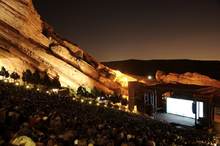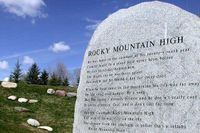- Music of Denver
-
While Denver may not be as recognized for historical musical prominence like such cities as Los Angeles, Detroit, Chicago or New York City, it still manages to have a very active popular, jazz, and classical music scene, which has nurtured many artists and genres to regional, national, and even international attention. Though nearby Boulder, Colorado has its own very distinct music scene, they are intertwined and often artists based there also play in Denver.
Contents
History
Folk music
As folk music gained popularity in the 1960s, a number of Denver's old folk clubs began to fill with then-unknown stars such as Judy Collins. Along with a population boom, the city gained much press for its rising music scene.
In the wake of the folk boom of the sixties came a country music boom in the early seventies, with such country-folk superstars like John Denver making names for themselves with songs inspired by the region. Denver himself was most famous for this.
Heavy metal
While mostly underground and still in existence today, Denver's metal scene has often been neglected by the press.
By the eighties, Denver turned more toward the growing pop music of the decade. While the metal scene grew notably during the early eighties in the city, more so did the local funk, R&B, jazz-fusion and hip hop scenes.
In the latter 2000's, math metal, doom metal, and Powerviolence flourished in the inner city's many DIY (as well as legal) venues.
Recent decades
With the 1980s came a new generation of music; grunge, thrash and nineties pop. Denver embraced all of these genres without trouble, most notably grunge. Like Seattle and a number of other cities who experienced the grunge boom, Denver fostered the genre in the early nineties before it quickly died out after the fall of the band Nirvana.
A number of festivals gained record attendance during the tenure of Mayor Wellington Webb, who worked to revamp the art community during his time as mayor. A small shock rock and Industrial metal scene developed in south Denver during the mid-nineties as a product of the vast underground metal and thrash scenes left over from the local hard rock up rise of the late seventies. As a result of the melting pot of styles being exhibited in the music scene at the time, a new revolution came to light: jam bands.
Jam and stoner
A direct result of many local metal fans fusing together with the vibrant jazz/funk and indie communities, the "jam band" style became prominent in Denver during the late nineties. Using methods common in sixties psychedelic groups and fusion artists such as Frank Zappa and Jimi Hendrix, jam bands were composed of a group "jamming" for extended periods, to which many genres were attributed. Local country music even entered the jam scene. In addition to the jam bands, stoner metal exploded in late nineties Denver as a response and as a complement to the jam scene. Using similar methods and popularized in trendy underground LoDo pubs, stoner metal was what many local hard rockers referred to as "the real product" of their endeavors. Legendary Desert rock acts such as Kyuss, Fu Manchu, and earthlings? made frequent stops in Denver during the Palm Scene renaissance of the 1990s.
Punk
Since the international punk surge in the late seventies, the style had been common place in the diverse underground, but had not had enough of a boom to gain regional popularity. Mostly known by local college students who had opposition to the metal underground, punk started to gain momentum in the late nineties, while oppressed under the jam/stoner movement.
As the millennium dawned, so did the up rise of east and central Denver punk rock and math rock. Under the same scene, the two styles had labored under different schools in the metro area but found common ground in their late nineties oppression. While still somewhat alienated by the Denver mainstream today, local punk rock remains a staple in the genre's national scene, especially in respects to the metro area's reputation for lively hardcore concerts.
Southern gothic
One of the largest and most influential scenes in Denver music during the 1990s and early 2000s was "southern" or "country" gothic, a style of dark and brooding Americana comprising elements of folk, country, and southern gospel. The rise of this style in Denver can be attributed almost single-handedly to David Eugene Edwards and his band 16 Horsepower and the many projects of the former members, such as Slim Cessna's Auto Club, Woven Hand (also consisting of Edwards), and Jay Munly & the Lee Lewis Harlots.
Classical
Denver has many performing ensembles dedicated to the Classical genre including the Colorado Symphony Orchestra, the state’s only full-time professional orchestra. Various community groups include the Denver Philharmonic Orchestra (formerly the Centennial Philharmonic), The Colorado Wind Ensemble, and The Denver Brass. The major youth ensembles are the Denver Young Artists Orchestra, the Colorado Youth Symphony Orchestra, and the Colorado Honor Band.
Well known music venues in Denver
- Boettcher Concert Hall
- Fiddler's Green
- Denver Center for the Performing Arts
- Ellie Caulkins Opera House
- Filmore Auditorium
- Mercury Cafe
- Ogden Theater
- Red Rocks Amphitheatre (located in the foothill region of Morrison, Colorado.)
Rhinoceropolis (Five Points Neighborhood)
Categories:- Music of Denver, Colorado
Wikimedia Foundation. 2010.


